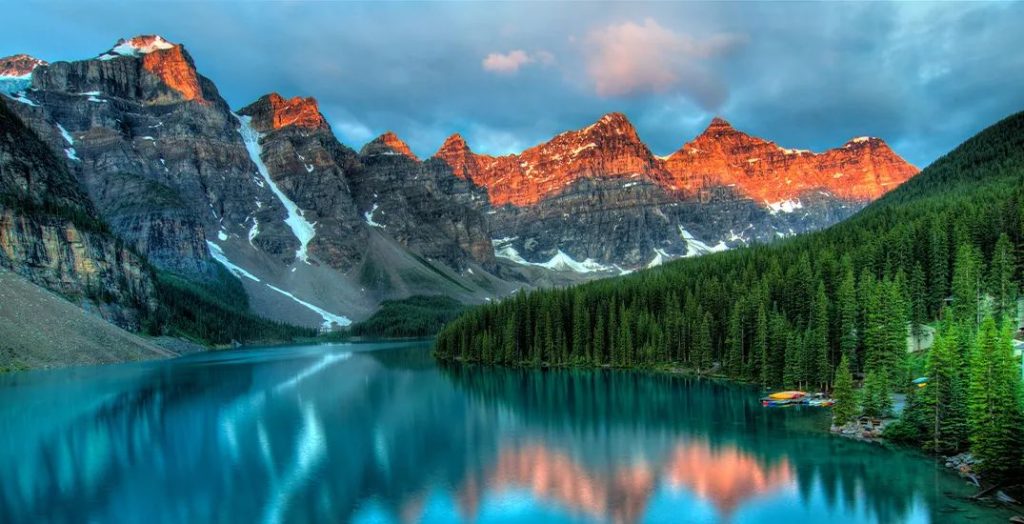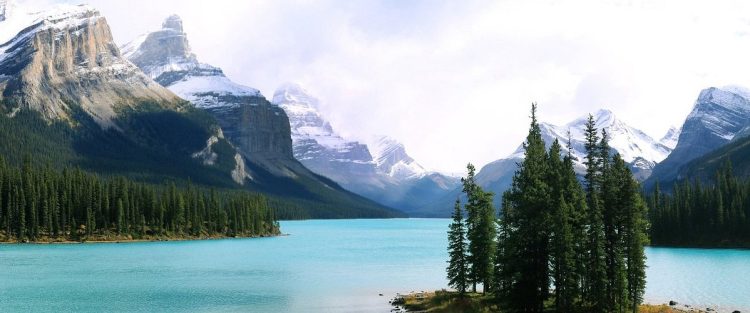The Rocky Mountains, stretching more than 3,000 miles from Canada’s British Columbia all the way to New Mexico in the United States, are one of the most iconic and awe-inspiring natural landmarks on the planet. With their towering peaks, deep valleys, crystal-clear lakes, and diverse ecosystems, the Rockies are not just a place to visit—they are an experience that will leave you feeling humbled and inspired. Whether you’re an adventure seeker, a nature lover, or a cultural enthusiast, the Rocky Mountains offer something for every traveler.
But what makes this mountain range so special? Why does it attract millions of visitors from all around the world each year? What can you expect when you travel to the Rockies, and how can you make the most of your trip to this vast and varied region? This travel guide will answer these questions and more, providing a comprehensive look at what you need to know before, during, and after your visit to the Rocky Mountains. From must-see locations and outdoor activities to cultural insights and travel tips, this guide has everything you need to plan your Rocky Mountain adventure.
The Geography of the Rocky Mountains: An Overview
The Rocky Mountains are a massive mountain range that spans across several U.S. states and Canadian provinces. This range has been shaped by millions of years of geological activity, including volcanic eruptions, glacial movements, and tectonic shifts. The result is a landscape full of rugged terrain, stunning vistas, and diverse ecosystems.
Key Features of the Rockies
- The Canadian Rockies:
- The Canadian Rockies are home to some of the most scenic and protected areas in North America, with UNESCO World Heritage Sites like Banff and Jasper National Parks. The landscape here is characterized by dramatic peaks, glaciers, hot springs, and crystal-clear alpine lakes, such as Lake Louise and Moraine Lake.
- The U.S. Rockies:
- The U.S. portion of the Rocky Mountains spans across several states, including Montana, Wyoming, Colorado, and New Mexico. From the majestic peaks of the Front Range in Colorado to the rugged wilderness of Yellowstone and Grand Teton National Parks, the American Rockies offer visitors countless opportunities for exploration and adventure.
- High Peaks and Mountain Passes:
- The Rocky Mountains are home to numerous high-altitude peaks, including Mount Elbert in Colorado, the highest summit in the U.S. Rockies, and Mount Robson in Canada, which stands as the tallest peak in the Canadian Rockies. In addition to peaks, visitors will find stunning mountain passes, such as Teton Pass and Berthoud Pass, which offer spectacular views.
Flora and Fauna: Biodiversity in the Rocky Mountains
The Rocky Mountains are known for their rich biodiversity. The range encompasses multiple climate zones, from temperate forests at lower elevations to alpine tundra at higher altitudes. As a result, the flora and fauna of the Rockies are incredibly diverse.
Flora
- Forest Vegetation:
- The lower elevations of the Rockies are dominated by forests of Douglas fir, ponderosa pine, lodgepole pine, and spruce. These trees provide vital habitats for many animals and are an essential part of the mountain ecosystem.
- Alpine Meadows and Tundra:
- As you ascend into higher elevations, the landscape changes. Alpine meadows are covered with wildflowers, such as Indian paintbrush and columbine, while above the tree line, you’ll find alpine tundra, home to mosses, lichens, and small shrubs.
- Unique Vegetation:
- The Rocky Mountains are home to many rare and unique plant species, including the Rocky Mountain columbine, the state flower of Colorado, and bristlecone pines, some of the oldest trees in the world.
Fauna
- Large Mammals:
- The Rockies are teeming with large mammals, such as elk, black bears, grizzly bears, mountain lions, bison, and moose. In national parks like Yellowstone and Rocky Mountain National Park, visitors can see these animals in their natural habitats.
- Birds and Raptors:
- The mountain range is home to a variety of bird species, including golden eagles, bald eagles, peregrine falcons, and mountain bluebirds. Birdwatchers flock to the Rockies for their impressive diversity of avian life.
- Small Mammals:
- You’ll also encounter smaller animals like marmots, pikas, mountain goats, and bighorn sheep. These creatures are especially common in the higher, more rugged areas of the Rockies.

Things to Do in the Rocky Mountains: Activities for Every Adventurer
The Rocky Mountains are an adventurer’s paradise, with countless opportunities for outdoor activities. Whether you’re into hiking, skiing, wildlife watching, or simply enjoying the breathtaking views, there’s something for everyone in this iconic mountain range.
Hiking and Backpacking
The Rocky Mountains are a hiker’s dream. With thousands of miles of trails ranging from easy strolls to challenging backcountry hikes, the Rockies offer diverse hiking experiences. Here are a few highlights:
- Rocky Mountain National Park (Colorado):
- Known for its high-altitude hiking trails, this park boasts over 350 miles of trails. The Longs Peak Trail is a popular route for experienced hikers, while Bear Lake offers a more accessible option for families.
- Banff National Park (Canada):
- In addition to world-famous landmarks like Lake Louise and Moraine Lake, Banff is home to many incredible hikes. The Plain of Six Glaciers and Johnston Canyon are both highly recommended.
- Yellowstone National Park (Wyoming):
- Known for its geothermal features, Yellowstone also offers stunning hikes, including the Uncle Tom’s Trail, which provides incredible views of Lower Falls, and the Lamar Valley, a prime spot for wildlife viewing.
Skiing and Snowboarding
During the winter months, the Rockies are a top destination for skiing and snowboarding enthusiasts. The region boasts some of the best ski resorts in the world, including:
- Aspen (Colorado):
- Famous for its luxury vibe, Aspen is one of the most iconic ski destinations in the world. With four mountains to choose from and an abundance of après-ski options, Aspen is perfect for those seeking both adventure and relaxation.
- Jackson Hole (Wyoming):
- Known for its challenging terrain, Jackson Hole offers expert-level runs and deep powder snow. The resort is also home to incredible wildlife and stunning views of the Teton Range.
- Whistler Blackcomb (Canada):
- The largest ski resort in North America, Whistler offers over 8,000 acres of skiable terrain, perfect for beginners to experts. The resort is renowned for its powder snow and diverse runs.
Wildlife Viewing and Scenic Drives
The Rockies are famous for their wildlife, and there are plenty of opportunities to spot animals in their natural habitats. Some of the best places for wildlife viewing include:
- Yellowstone (Wyoming): Known for its bison herds, wolves, and grizzly bears.
- Banff and Jasper National Parks (Canada): Elk, moose, mountain goats, and even wolverines are frequently spotted.
- Rocky Mountain National Park (Colorado): A prime location for spotting elk, mule deer, and black bears.
For those who prefer a more relaxed activity, scenic drives like the Going-to-the-Sun Road in Glacier National Park and the Trail Ridge Road in Rocky Mountain National Park offer breathtaking views of the landscape without the need for strenuous hiking.
Cultural and Historical Significance of the Rockies
The Rocky Mountains have a rich cultural and historical significance, shaped by thousands of years of Indigenous history and the expansion of European settlers.
Indigenous History
The Rockies have been home to numerous Indigenous tribes for millennia. These include the Blackfeet, Shoshone, Navajo, and Ute peoples. For Indigenous communities, the Rockies are sacred, and their stories and traditions are deeply connected to the land.
European Exploration
The Rockies were first explored by Europeans in the early 19th century. Pioneers like Lewis and Clark, John C. Frémont, and Jedediah Smith were among the first to chart the region, facing daunting challenges as they navigated the treacherous terrain. Their explorations helped open the way for settlement and expansion to the West.
Modern-Day Rockies
Today, the Rockies are not only a popular destination for outdoor enthusiasts but also a hub for cultural expression. The region hosts art festivals, music events, and historical reenactments, providing a rich cultural experience for visitors.
Planning Your Trip to the Rocky Mountains
The Rocky Mountains are a large and diverse region, so planning your trip is essential to making the most of your time there. Here are some tips to ensure a smooth and enjoyable trip.
Best Time to Visit
- Summer (June to August): The most popular time for outdoor activities like hiking, climbing, and wildlife watching. Many trails and national parks are accessible during these months.
- Fall (September to October): A quieter time to visit, with fewer crowds and the added bonus of beautiful fall foliage, especially in Colorado.
- Winter (December to February): Ideal for skiing and snowboarding. The colder months also offer a serene and peaceful atmosphere, especially in places like Yellowstone and Banff.
- Spring (March to May): A great time to visit if you’re looking for fewer crowds and the opportunity to see wildflowers in bloom.
Where to Stay
From luxury resorts to rustic cabins and campgrounds, the Rockies offer a wide range of accommodation options. Popular places to stay include:
- Aspen (Colorado): Known for its luxury hotels and private chalets.
- Jackson Hole (Wyoming): Offers a range of accommodations, including charming lodges and five-star hotels.
- Banff (Canada): Featuring cozy mountain lodges and high-end resorts with picturesque views.
Getting Around
- Driving: Renting a car is often the best way to explore the Rockies, as it gives you flexibility to visit multiple national parks and scenic drives.
- Public Transport: Some cities in the Rockies offer bus services and shuttles to popular attractions. However, public transport options can be limited in remote areas.
Conclusion: Why Should You Visit the Rocky Mountains?
The Rocky Mountains are more than just a mountain range—they are a living testament to the beauty and power of nature. From rugged peaks to pristine lakes and thriving ecosystems, the Rockies offer an experience like no other. Whether you’re seeking adventure, tranquility, or cultural immersion, this majestic region has something to offer.
So, why should you visit the Rockies? Because it is a place where you can truly connect with nature, challenge yourself, and witness the beauty of the world in its purest form. Whether you’re climbing to a summit, spotting wildlife in a national park, or simply enjoying the view from a scenic drive, the Rocky Mountains will undoubtedly leave a lasting impression on you.





















